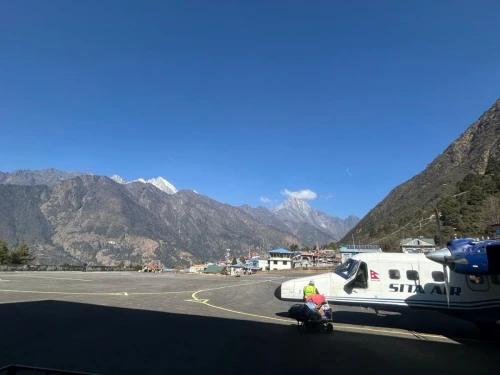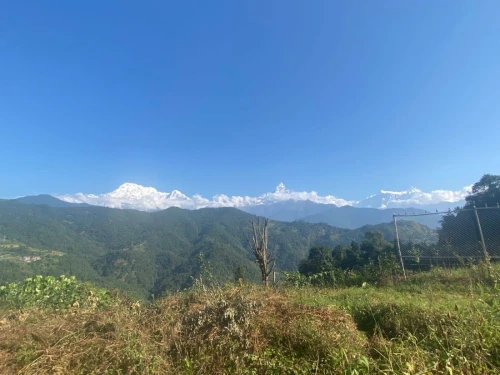Characteristics of Yak
Yaks are ideally suited to the high altitudes and cold of the Himalayas because of their thick, woolly coats, which give them a large, robust appearance. Their lengthy, bushy tail serves as insulation from freezing temperatures.
They also have long and curved horns, which are useful for digging through snow to find grass and defending against predators. Because of their large lungs, which enable them to survive in thin air, Yaks are able to survive at such high altitudes where oxygen levels are low.
Speaking of the weight of these Himalayan beasts, yaks can range in weight from 300 kg to 1000 kg, depending on their environment. Because of their strong physique and constant speed, they are nicknamed "Mountain Tanks".
In suitable alpine habitats, yaks can live for 20 to 25 years. They are peaceful and quiet, and they frequently use deep grunts rather than loud calls to communicate.
Types of Yak in Nepal
There are several varieties of yaks in the Himalayan region, depending on their habitat and characteristics. You will encounter three different kinds of yaks on your trek and adventure in Nepal: domestic, wild, and Chauri.
The following table demonstrates a thorough comprehension of the various Yak species and their unique characteristics.
| Domestic Yak | Wild Yak | Chauri |
| The yaks, which are domesticated by locals of the Himalayan villages. | The yaks found in the wild of the mountain region are an endangered species and protected due to habitat loss and hunting. | Yaks and domestic cows are crossed to create hybrids known as chauri. |
| Domesticated Yaks are more common and found in mountain villages across Nepal, Bhutan and Tibet. | Extremely rare and powerful, wild Yaks inhabit altitudes of 4,000–6,000 metres and are primarily found in Tibet, the Dolpo, and the upper Mustang. | Compared to yaks, they can adapt better to warmer climates and lower elevations. |
| They are calmer than wild yaks and are used for meat, dairy, transportation, and wool. | They can weigh more than a tonne and stand up to two metres tall. | Chauri are commonly raised in Nepal’s mid-hill regions for milk and farming work. |
Lifestyle and Behaviour of Yaks
As herbivorous grazers, yaks primarily consume alpine grasses, herbs, and shrubs that grow in high-altitude meadows. In order to find dry grass or stored fodder, they typically descend to lower valleys during the winter, while in the summer they graze in high meadows above 4,000–5,000 metres.
One of the amazing pieces of Yak information and facts is that they live in small herds, which are led by an older female. The herd ensures the protection and unity among all the members.
You wouldn't want to see the ferocious side of the Himalayan Yaks, which are generally peaceful by nature and only ever act aggressively when threatened or defending their calves.
It may surprise you to learn that Yaks can swim across icy rivers for both seasonal migration and when they are moving between grazing areas.
Yaks Interesting Facts
- A fully grown yak's massive lungs and high red blood cell count allow it to survive in areas where oxygen levels fall below 60% of sea level.
- Wild yaks can run up to 40 km/h and easily traverse steep, icy terrain despite their enormous build.
- Their hair can reach a length of 60 centimetres, which gives them insulation that can withstand temperatures below -40°C.
- Yaks rarely sweat, which helps them conserve vital body heat and energy in the harsh Himalayan cold.
- Dried yak dung is burnt as fuel for ceremonies or used to write Buddhist mantras on walls in many monasteries.
- Yak herding is the only source of income for some of the highest human settlements on Earth, including Dolpo and Mustang.
- Domestic yaks are dependable companions in the mountains because they are calm and devoted by nature, and they can recognise the voices of their herders.
- Because they graze in patterns that limit over-erosion, they are essential to the preservation of delicate alpine ecosystems.
- At high elevations, yak butter tea and milk products are vital sources of warmth and energy, even for hikers.
Importance of Yaks in Himalayan Life
The Himalayan way of life would be difficult to sustain without yaks, which are among its most essential components. Yaks are important for connecting remote villages and trekking routes, as well as for transporting heavy loads (60–80 kg) on steep trails that are inaccessible to vehicles.
They also provide the mountain communities with milk, butter, cheese, chhurpi, and meat, all of which are important sources of nutrition for the region and adventurers. Additionally, in high-altitude regions where firewood is limited, dried yak dung can be used as an environmentally friendly fuel for heating and cooking.
While trekking in the Himalayan region of Nepal, you will see the local handicrafts, such as jackets, shawls, and warm blankets made from Yak wool. They are major aspects of trade.
As a symbol of power, good fortune, and the life of mountains, yaks are frequently seen in Tibetan Buddhist traditions, festivals, and rituals. Most importantly, Yaks are essential to local livelihoods, tourism, and trade; they support the trekking industry and support the economies of the Himalayas on a large scale.
Yak Products
- Yak Cheese (Chhurpi): A classic Himalayan snack, this hard, chewy cheese is high in calcium and protein and is cherished by hikers for its long shelf life and energy boost.
- Yak Butter: Rich and fragrant, it's well-known for being used in Tibetan Butter Tea (Po Cha), which provides hydration, calories, and warmth in the icy highlands.
- Yak Wool: Prized for its longevity and insulation, it is spun into blankets, carpets, and warm sweaters. It is softer and warmer than ordinary sheep wool.
- Yak Meat: Yak meat is a nutrient-dense, low-cholesterol, lean meat that is popular among trekkers and Himalayan communities.
- Yak Milk: Rich in nutrients and creamy, it is an essential component of the mountain diet and is used to make cheese, butter, and yoghurt.
- Yak Tail & Horns: Deeply spiritual and artistic, they are frequently fashioned into religious ornaments, ritual fans, and cultural symbols.
- Yak Hide & Leather: The thick and resilient hide is used to make traditional saddles, boots, and tents, demonstrating the craftsmanship of the Himalayas.
Yaks in Trekking and Mountain Tourism
Yak caravans are frequently encountered on treks through Nepal's mountainous regions, such as the Everest Base Camp Trek, the Annapurna Circuit, Langtang Valley, and the Manaslu region, where they are a common sight at higher elevations.
Remember that the yaks that carry the supplies and maintain high altitude tourism are responsible for providing the amenities you find in the mountains, such as food, tents, equipment and gas cylinders for the lodges and base camps.
The best thing about yaks is that they are natural carriers, which lowers pollution and fuel consumption. Yaks keep the trails environmentally friendly and help protect the delicate alpine ecosystems.
Because their heavy loads can cause slips on narrow paths, trekkers are advised to stand up on the uphill side and give room when yak caravans pass. The unmistakable sound of Himalayan adventure is the gentle clinking of yak bells resonating through the valleys on any trek above 3,000 metres.
In Conclusion
If you've read this far, you must now have a thorough understanding of Yaks and their lifestyle in the mountains. They are the symbols of resilience and life in the Himalayas.
Yaks support high-altitude communities by carrying supplies across rugged trails and providing food, wool, and a means of livelihood. Experiencing the wild, majestic, and enduring spirit of the Himalayas is what it is like to encounter Yaks on the trek.
Trekking with Mount Glory Treks gives visitors the chance to experience the spirit of the Himalayas and walk the same paths that yaks have been using for centuries. From traditional yak cheese tasting to yak caravans traversing icy passes, you can select from a variety of our packages.
To ensure that future generations can see the mountains as they were intended to be, it is crucial to preserve the significant Yaks and their habitats. Yak trails, alpine beauty, and ageless customs abound in the Himalayas.
Frequently Asked Questions
1: What is a yak, and where are they found in the Himalayas?
Yaks are high-altitude cattle that live in northern India, Tibet, Bhutan, and Nepal at elevations above 3,000 metres.
2:What is the difference between domestic and wild yaks?
Wild yaks are rare, larger, and found in isolated alpine regions, whereas domestic yaks are gentler, smaller, and used by humans.
3:How much can a yak carry on high-altitude trails?
Yaks are capable of carrying 60–80 kg over the rough terrain of the Himalayas.
4: How long do yaks live in the mountains?
Yaks can survive at high elevations for 20 to 25 years.
5:How are yaks adapted to survive extreme cold and thin air?
Yaks can withstand harsh climates thanks to their thick coats, big lungs, high red blood cell count, and low sweating.
6:What is a hybrid yak or chauri?
A chauri, a hybrid of a domestic cow and a male yak, is used for dairy production and farming at lower elevations.
7:How long do yaks live in the mountains?
Yaks can survive at high elevations for 20 to 25 years.
8:What products are made from yak milk and butter?
Ghee, yoghurt, butter tea, and cheese (chhurpi) are all made with milk and butter.
9:How is yak wool used in Himalayan clothing and crafts?
Warm jackets, carpets, sweaters, and blankets are all made from spun yak wool.
10:Are yaks dangerous to trekkers?
Although they are usually peaceful, they may become hostile if they feel threatened or need to defend their young.
11:What role do yaks play in Himalayan tourism?
In addition to supporting trekking lodges and transporting supplies, they offer trekkers scenic and cultural experiences.
12:How do yaks help preserve fragile mountain ecosystems?
By carrying loads rather than vehicles, they help to reduce trail erosion and pollution.
13:Can wild yaks be spotted on trekking trails in Nepal?
Although they are uncommon, wild yaks can be found in high alpine regions, Upper Mustang, and Dolpo.
14:How fast can a yak run, and how strong are they?
In addition to carrying heavy loads over steep trails, wild yaks can run up to 40 km/h.
15:What cultural or religious significance do yaks hold in Nepal and Tibet?
Yaks are used as a symbol of power and wealth in Buddhist festivals, rituals, and traditions.
16:How are yak dung and hides used by local communities?
While hides are used to make saddles, boots, and tents, dung is used as fuel and in monasteries.
17:Which trekking routes in Nepal are famous for yak sightings?
Manaslu Region, Langtang Valley, Annapurna Circuit, and Everest Base Camp.
18:What is Chhurpi, and why is yak cheese popular?
Chhurpi is a hard, high-protein yak cheese that is prized for its long shelf life and ability to provide energy during hikes.
19:How do yak herders migrate their animals in the Himalayas?
Yaks are seasonally moved by herders between lower winter valleys and high summer pastures.
20:Why is it important to conserve yaks and their natural habitats?
Yak conservation maintains Himalayan culture, protects ecosystems, and guarantees sustainable livelihoods.



 4 reviews
4 reviews




